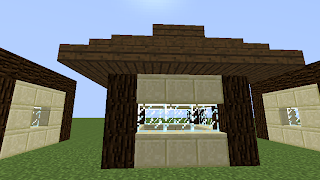For example, suppose I wanted to make a couple desert buildings. Here are some modules I might use:
An entrance:
A sort of living room area:
A general purpose module:
And a roof module:
The visual design aspect of the game was handled in these parts. All that is left is to come up with good ways of putting them together. Here are two I've come up with.
And that is the basics of modular design. You can build as big or as small as you feel inclined to.
The advantages of using modular design lie in how it pushes the burden of design on smaller, more manageable sections.
- Buildings can be more quickly made by simply combining the various modules together.
- They give an appearance of physical unity, bringing together multiple builds.
- Minor variations can be added, thereby giving variety without breaking the overall style.
- It can be used to emphasize or accentuate a build that isn't modular, while still looking good.
The primary disadvantage to this method of building is that things will look alike. A lot. This can me minimized by varying the dimensions of modules, blocks used, shapes, and so on.
This is, most likely, the method I will be using from now on for my builds. In tandem with techniques for designing things, hopefully my stuff will become a lot better looking!
This is, most likely, the method I will be using from now on for my builds. In tandem with techniques for designing things, hopefully my stuff will become a lot better looking!







